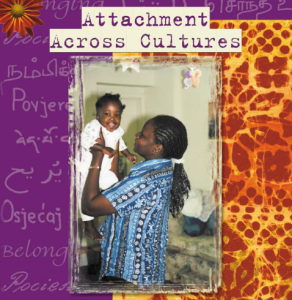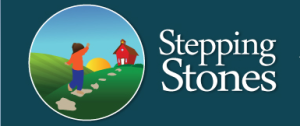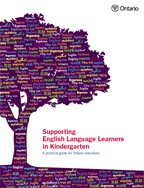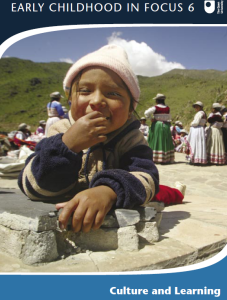 Promising Practices of Early Childhood Education for Immigrant and Refugee Children in British Columbia
Promising Practices of Early Childhood Education for Immigrant and Refugee Children in British Columbia
This document and related links provide an excellent starting point that will help  enhance awareness, professional networking and foundations for future knowledge development for professionals focusing on early care and learning in settings that serve immigrant and refugee children and their families. This guide is based on the collective insight from interviews of qualified early childhood educators. It presents promising practices and key themes when working with newcomer children and their families.
enhance awareness, professional networking and foundations for future knowledge development for professionals focusing on early care and learning in settings that serve immigrant and refugee children and their families. This guide is based on the collective insight from interviews of qualified early childhood educators. It presents promising practices and key themes when working with newcomer children and their families.
Ensuring “the development of the child … to the maximum extent possible” is part of every child’s rights under the UN Convention on the Rights of the Child. But to what extent is “development” a cultural process that varies between societies, or a natural process that is the same for all children? This edition of Early Childhood in Focus, from the Child and Youth Studies Group at The Open University, United Kingdom,explores notions of caregiving, communication, and participation and addresses the major policy questions surrounding the place of culture in early childhood programmes, and how to promote development and learning while respecting cultural diversities.
 Attachment Across Cultures Toolkit
Attachment Across Cultures Toolkit
The report is the result of an exploratory research project to identify the attachment practices of diverse parents with children aged 0-5 years across Canada. In addition, the  project aimed to assist organizations in promoting and maintaining positive cross-cultural attachment practices among program participants, by creating practical resources for them.
project aimed to assist organizations in promoting and maintaining positive cross-cultural attachment practices among program participants, by creating practical resources for them.
 Stepping Stones: A Texas Migrant Early Childhood Program for 3- and 4-Year-Olds was developed in partnership with the Texas Education Agency (TEA) to provide resources for home-based pre-kindergarten programs. Although designed to support migrant children and their families in Texas, these resources would be useful for Canadian programs for young learners of refugee backgrounds. The resources consist of 100 lessons bundled into sets of ten lessons around early learning themes or units. The lessons heavily emphasize language and literacy development and follow a “gradual release of responsibility” model that empowers parents to be successful teachers of their children, with guidance from a home visitor. Along with the lessons, a manual is available to guide home educators and migrant program coordinators in effective implementation of the program.
Stepping Stones: A Texas Migrant Early Childhood Program for 3- and 4-Year-Olds was developed in partnership with the Texas Education Agency (TEA) to provide resources for home-based pre-kindergarten programs. Although designed to support migrant children and their families in Texas, these resources would be useful for Canadian programs for young learners of refugee backgrounds. The resources consist of 100 lessons bundled into sets of ten lessons around early learning themes or units. The lessons heavily emphasize language and literacy development and follow a “gradual release of responsibility” model that empowers parents to be successful teachers of their children, with guidance from a home visitor. Along with the lessons, a manual is available to guide home educators and migrant program coordinators in effective implementation of the program.
 Supporting English Language Learners in Kindergarten: A practical guide for Ontario educators
Supporting English Language Learners in Kindergarten: A practical guide for Ontario educators
Supporting English Language Learners in Kindergarten: A practical guide for Ontario educators is designed as a resource and tool for teachers, administrators, and other school staff as they support ELLs in achieving the overall expectations in a Kindergarten program. Although aligned to the Ontario program of studies, the information is still valuable for practitioners in other provinces. This resource provides a rich source of research findings, practices, and strategies that can be put to immediate use in the school and the classroom. There is also information on working with families and communities, and working as a whole school to provide a quality beginning school experience for ELLs.

Working with Young Learners who are Learning English as a New Language
This 2009 guide is intended to support early learning professionals better understand second language acquisition, the relationship between English and first language and culture, and ideas for programming to enhance English language learning for young children.
BRYCS serves as a clearinghouse of information related to best practices in services for refugee children and youth in the United States. The “Family Strengthening” section of their website supports service providers to assist refugees with integration and daily functioning, such as literacy development, culturally relevant child care, family functioning, marriage development, and parent-child programming. BRYCS’ family strengthening resources are used to aid newcomer parents in understanding U.S. childrearing expectations, to build and support refugee family stability, and to promote collaboration with ethnic community organizations, in order to support and strengthen refugee family relationships as they integrate into American society. Although this is an American site and the legal framework, funding sources and agencies are particular to regions, the innovative ideas being described are inspirational and could be copied and implemented within the Albertan/Canadian context.
Raising Children in a New Country: A Toolkit for Working with Newcomer Parents
A BRYCS publication, this document is a compendium of resources to support agencies offering cross-cultural parenting workshops. While not particularly geared to school personnel, the initial chapters about the challenges parents face are helpful for sensitizing staff.
Raising Children in a New Country: An Illustrated Handbook
This BRYCS publication is a downloadable easy-English highly visual illustrated guide for newcomer and refugee parents with information about supervising and disciplining children, home safety, car safety, public safety, healthy sleeping and eating habits, school expectations and chores. Although the text refers to “the U.S.” the material is easily transferrable to Canada. This booklet has been translated into Arabic, Nepali, Spanish, and Hmong by other agencies. BRYC can provide additional information about how to access them.
Helping Children Cope with the Stresses of War: A Manual for Parents and Teachers
This publication by Mona Macksoud for Unicef (2000) gives descriptions (illustrated by reproductions of children’s drawings) of nine wartime experiences that cause stress in children. General guidelines on handling the ‘problem behaviours’ with which children of various ages respond to stress are also presented. Ten specific problem behaviours ranging from bed-wetting to risk-taking are described, followed by practical advice on how parents and teachers can deal with them.
Washington Learning Systems: Literacy Resources
The On-the-Go Resources provide fourteen home and community activities show how to promote language and early literacy during everyday activities. The downloadable materials are available in English, Spanish, Vietnamese, Mandarin, Somali, Russian and Burmese.
The Centre for Family Literacy provides a wide range of adult and family literacy programs in Edmonton, as well as training, resources, information and advocacy across the Province. The Alberta Prairie (Classroom on Wheels) C.O.W. bus brings family literacy support and awareness to rural and urban communities throughout the province.
Talking is Key…Tips for Helping Children Learn Language
The Talking is Key DVD, available in English and 11 additional voice overs, was developed by the Preschool Speech and Language Services program of the Calgary Health Region, with funding from the Alberta Children’s Hospital Foundation. The Videos can be downloaded from the Parent Link Alberta site.
Alberta Education has created Curriculum Express for Parents which provide a short explanation of school and what students learn from Kindergarten to Grade 3 – for parents who are English language learners. They are a visual and easy English explanation of the Alberta Program of Studies, available in general and Catholic versions. They include ideas about how parents can engage with schools and assist their children at home.











